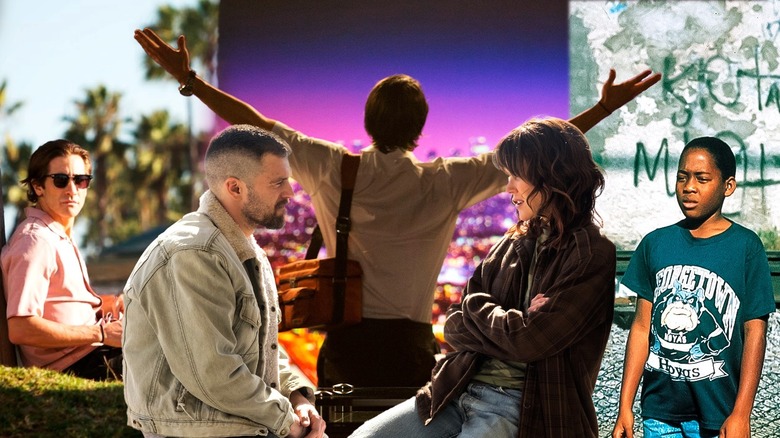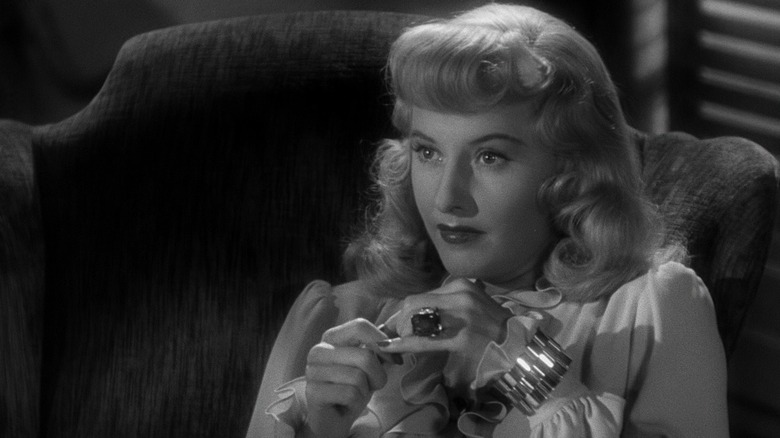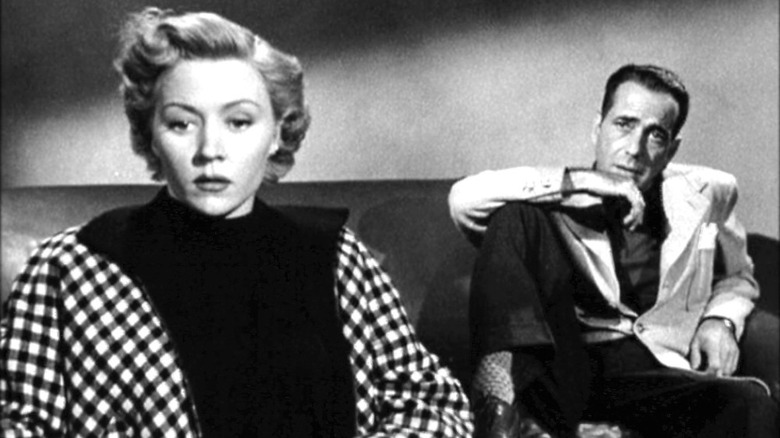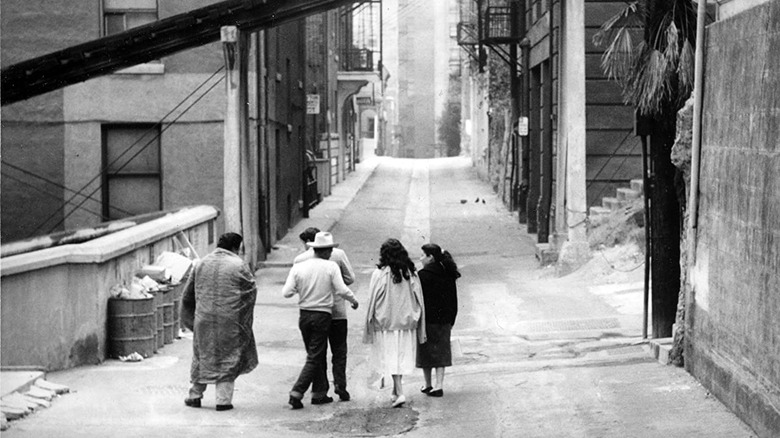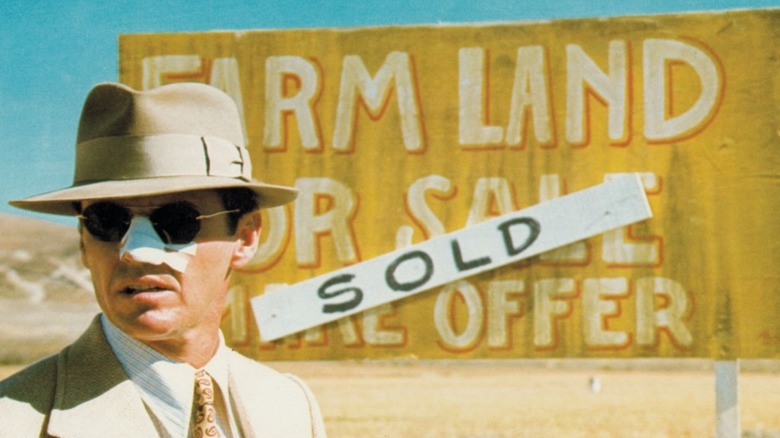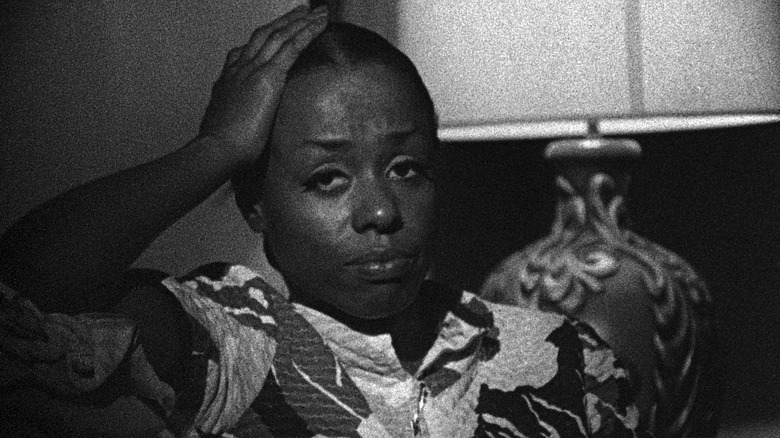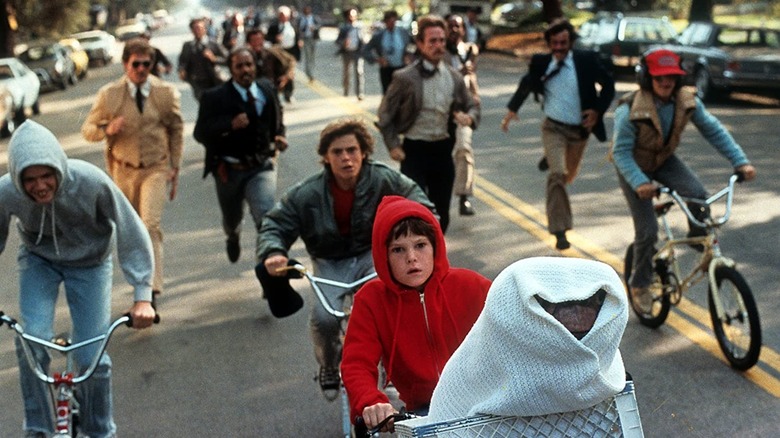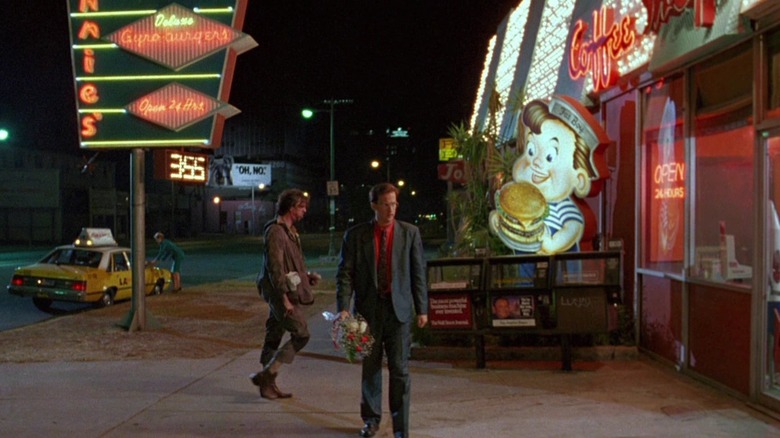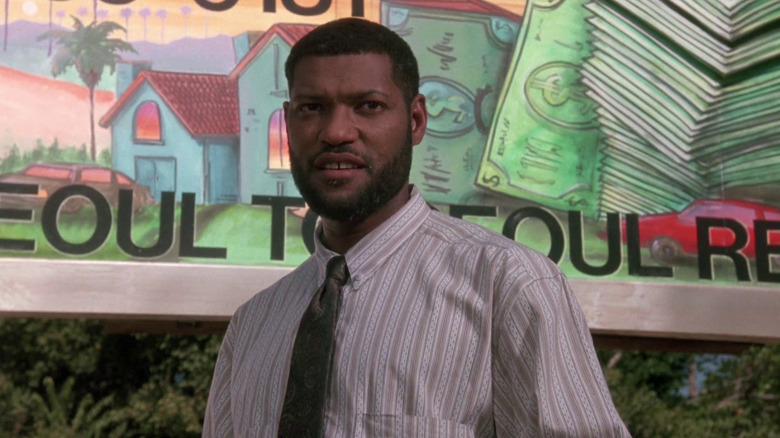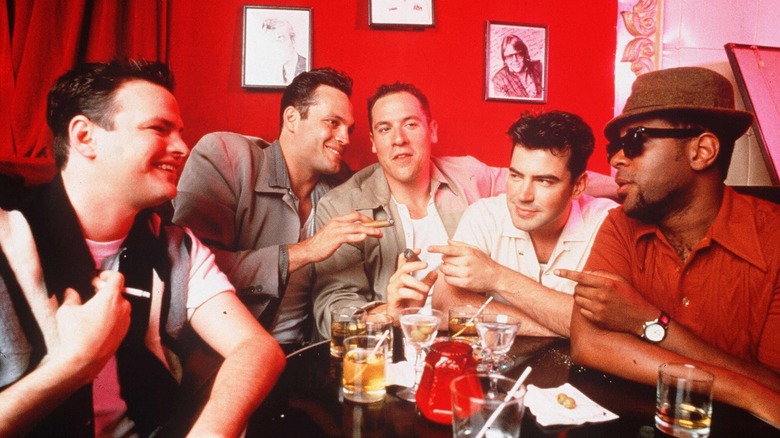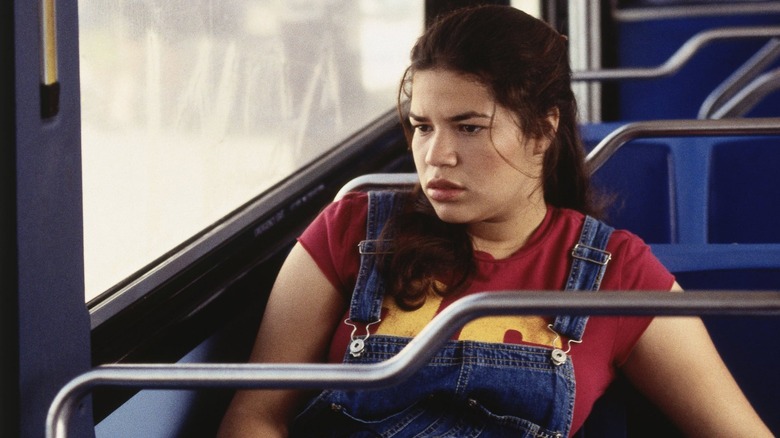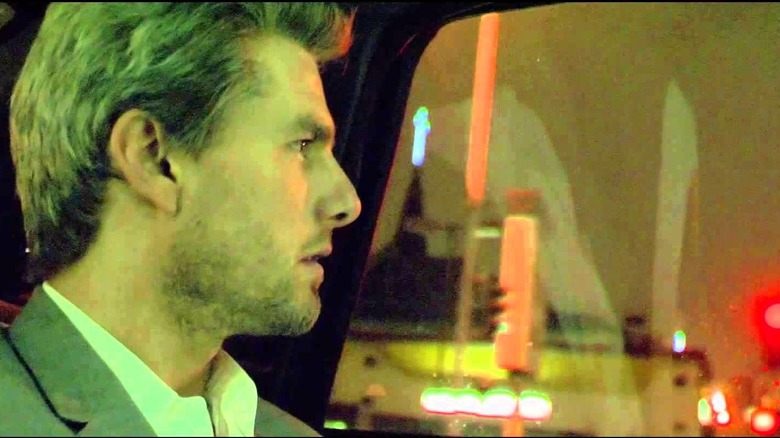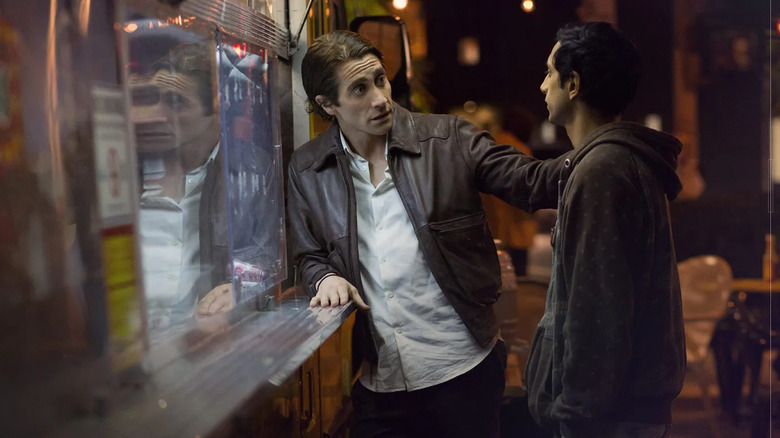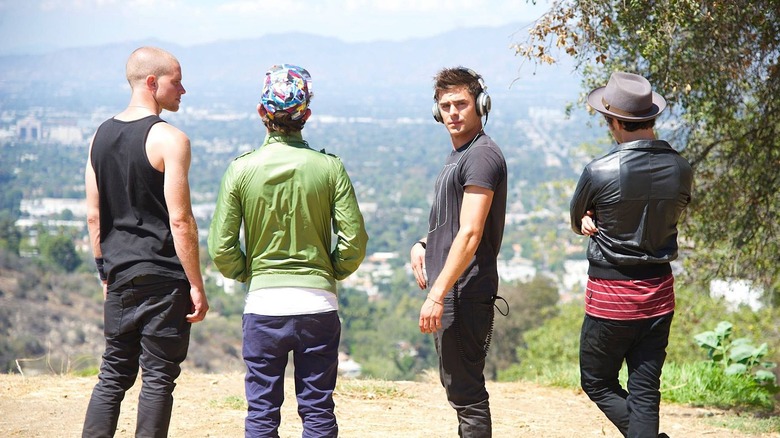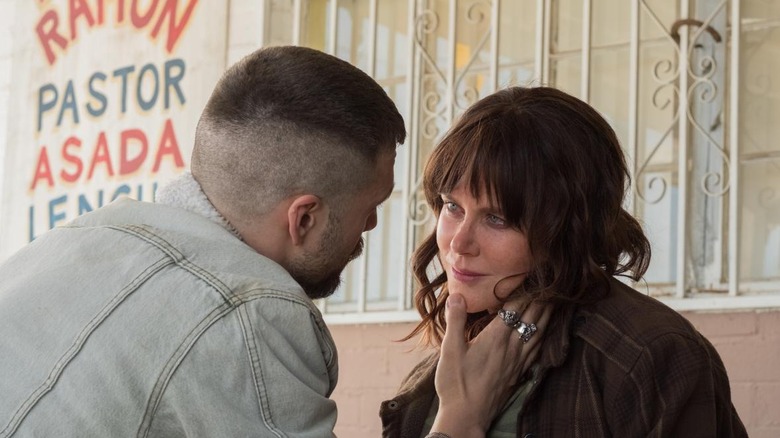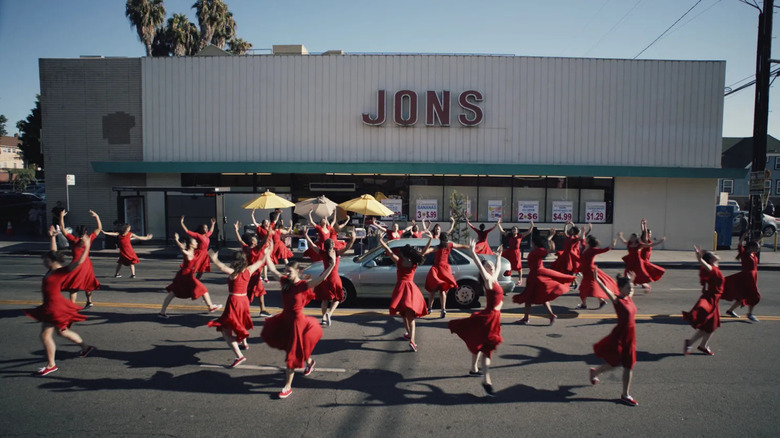The 15 Best Movies About Life In Los Angeles, According To Someone Who Lives There
Los Angeles is such a large and sprawling city, it doesn't have a singular identity. As can be seen from the wide variety of movies set here, neighborhoods in the east, south, and west of LA, from the beaches to the vast San Fernando Valley, all have extremely different flavors. LA is a city of transplants and immigrants, and I'm no exception, as I moved here 6.5 years ago from the UK. Most of the best-known LA movies were made by outsiders trying to get to grips with a city that in one sense is dominated by the movie industry but also has a rich cultural life outside of that.
One of the best ways to discover LA is through documentaries, such as "City of Gold" (2015), "Los Angeles Plays Itself" (2003), and "Dogtown and Z-Boys" (2001). Like most people, my perception of LA was entirely built by the movies I watched growing up, and I had a romantic sense of it being a destination that one reached at the end of Route 66, filled with diners in the best Googie style. Living here is of course more complex, but stereotypes such as LA's awful traffic are unfortunately true.
I make no apology for including several movies set in the non-glamorous location of the Valley; some may say that it doesn't even count as proper LA, but it's where millions of people live out the reality of their LA lives. This city is complicated and extremely hard to define or pigeonhole, as can be seen in these 15 best movies about life in Los Angeles.
Double Indemnity (1944)
It would be extremely easy to populate a list of the best LA movies solely with LA noir. The noir movie is the ultimate expression of Los Angeles — it's a city of glossy facades hiding corruption and evil. In "Double Indemnity," Fred MacMurray's Walter Neff has his fate sealed the moment he pulls up to "one of those California Spanish houses everyone was nuts about 10 or 15 years ago" and locks eyes with Barbara Stanwyck's Phyllis Dietrichson (and her anklet). The Dietrichsons' Colonial Revival home is maybe the most important location here, certainly in terms of unlocking Mrs. Dietrichson's character. She represents the banality of evil, and as Thom Andersen says; "the phony historicism of the architecture and interior decor reflects the dishonesty of the lives contained within." Neff is seduced by the scent of honeysuckle all along the Dietrichsons' street; "How could I have known that murder can sometimes smell like honeysuckle."
Another essential location is Jerry's Market on Melrose; the setting for the lovers' rendezvous where they discuss their dastardly plans. Stanwyck's perfectly coiffed hair and dark sunglasses as she furtively whispers not-so-thinly-veiled threats at Walter over the baby food makes for an unforgettable image. Neff and Mrs. Dietrichson's scheme is as tightly and conveniently packaged as the tins and boxes of prepared foods that housewives browse nearby. But as with all noirs, the plans will unravel and the patsy will fall afoul of the femme fatale. "Double Indemnity" reveals the self-centered underbelly behind the perfect veneer of '40s and '50s Los Angeles.
In a Lonely Place (1950)
It begins in the most LA way possible; from inside a car, driving down busy city streets. "In a Lonely Place" is an example of a source novel and a film adaptation both being brilliant in very different ways — and Nicholas Ray makes Dorothy B. Hughes' book way more Hollywood. Dix Steele is the protagonist, and an undisputed serial killer in Hughes' shocking novel, but the film brings more doubt and ambiguity to his character. Making him a screenwriter in the movie is also an amusing difference, especially as he is supposed to be adapting a novel, and wants to make big changes. Within minutes of being introduced to Bogart's Steele, he is embroiled in a road rage incident and then signing autographs — this guy sure belongs in LA.
The complex where Dix and Gloria Grahame's Laurel Gray both live feels extremely Los Angeles; one-and-two-floor apartments are laid out around an attractive central courtyard. The ill-fated hat-check girl Mildred Atkinson says of the Patio Apartments, "My what a pretty place, sorta hacienda like, isn't it?" This type of structure can be seen in a range of LA movies, such as David Lynch's "Mulholland Drive" and the rom-com "A Lot Like Love," and is appealing to out-of-towners. Dix Steele is one of Bogart's most intricate characters; he always has violence bubbling away under the surface, bringing a constant queasy uneasiness to the atmosphere. The movie's heart-wrenching closing line "I lived a few weeks while you loved me" demonstrates that Los Angeles really is a lonely place.
The Exiles (1961)
An early example of an LA movie that takes place mostly over the course of one night, and which feels way ahead of its time, is Kent McKenzie's examination of young Native Americans exiled from Arizona and now living in Bunker Hill. "The Exiles" captures this so-called "blighted community" when it was on the cusp of being completely redeveloped. The area's Angels Flight funicular can be seen in noir movies such as "Criss Cross" and "Kiss Me Deadly." "The Exiles" takes the real people of Bunker Hill and creates a loose narrative, in which they're playing "characters" closely based on themselves.
The most tragic and compelling figure is Yvonne, a pregnant woman who is left behind when her husband Homer goes out on the town with his friends. McKenzie's direct cinema style follows these young people bar-hopping around the area in their convertibles. Homer has a flashback to his reservation in Arizona, which brings into sharp relief the stark contrast between where they've come from and where they are. They have assimilated to the city, with their greaser hairstyles, playing rock 'n' roll on the dive bar jukeboxes, and spending their meager paychecks on booze.
Your attention and sympathy are always pulled towards the women, such as the one who pays for gas and then is left behind at the gas station, or the ones manhandled at the forty-nine dance on 'Hill X' in the movie's finale. McKenzie's camera observes without judgment, and we are left with a stunning record of a specific place, people, and time.
Chinatown (1974)
Noir and neo-noir have always been the best genres for exposing how institutions can hold cities in a stranglehold. But they are frequently rotten to the core, as seen in the police ("LA Confidential"), the car industry ("The Nice Guys"), and public transportation ("Who Framed Roger Rabbit?"). In "Chinatown," Los Angeles' water problem is at the heart of the mystery. The film does a superb job of conveying the desert surrounding LA — always threatening to encroach — and shows you don't have to travel far from LA's fringes (even today) to find farmers eking out a livelihood.
"Chinatown" also includes one of the best LA movie tropes, when Jake Gittes (Jack Nicholson) is left carless for the second half of the movie, making things infinitely harder and more frustrating. We've seen in "Falling Down," "Under the Silver Lake," and "Izzy Gets the F*** Across Town" that being carless in LA renders characters impotent and they have to become inventive to get things done. The need for both cars and water are two defining features of LA, as is the thick layer of corruption and greed underpinning the "city of stars."
"Chinatown" shows many different sides to LA, from Echo Park Lake to City Hall, and, of course, to Chinatown itself, but it excels when it reaches out to more far-flung locations such as Noah Cross' ranch filmed in Rancho Palos Verdes and Catalina Island, Stone Canyon Reservoir, and the Mulwray mansion in Pasadena. It's one of the best-ever films to place LA in its geographical context.
Killer of Sheep (1978)
Another LA movie that feels way ahead of its time is Charles Burnett's debut work. Inspired by the Italian neorealist movement and filmed on a shoestring budget in Watts with non-professional actors, "Killer of Sheep" gives a unique insight into working-class Black life in LA. Stan (Henry G. Sanders) is the titular "killer of sheep," as he works in a slaughterhouse, but by far the most moving and magnetic character is his unnamed wife (Kaycee Moore). Much like Yvonne in "The Exiles," she is a heartbreakingly lonely figure, one who tries to reach out to her man, but he struggles with tenderness and communication. A scene where they dance by a window is the highlight, and just shattering to watch.
The film has plenty of humor as well, provided by the vast amounts of children in the neighborhood, as well as Stan's friends who struggle with broken-down cars and dabble in petty crime. There's no narrative to speak of, but that makes for the best and most LA movie possible. A series of vignettes, involving chance encounters, meandering through a neighborhood (or the whole city) gives a loose, relaxed yet chaotic feel — and that is LA. Robert Altman, Paul Thomas Anderson, and more have made these kinds of movies here, but Burnett points the camera at his own Black community, and we meet the kind of people who were rarely depicted onscreen at the time. We're extremely lucky that "Killer of Sheep" has been saved and preserved, as it's a landmark LA movie.
E.T. the Extra-Terrestrial (1982)
In 1982, two movies were released a week apart, which had been filmed in the San Fernando Valley and nearby Simi Valley with the heavy involvement of Steven Spielberg. "E.T." was shot in various locations around LA, including Northridge. The Halloween scene and the bicycle chase that leads into the iconic flying Spielberg moment were both filmed in Porter Ranch. Tobe Hooper's "Poltergeist," which Spielberg co-wrote and produced, had completed filming in Simi Valley exactly a month before "E.T." began shooting.
For someone growing up in the U.K. at the time, the suburban streets depicted in these two movies represented a quintessential Americana, with the backdrop of the mountains and cypress trees making them look particularly appealing. Much more than "Valley Girl," the feeling of nostalgic comfort engendered by "E.T." and "Poltergeist" is what was foremost in my mind when we moved initially to Ventura County near Simi Valley, then to the Valley near Northridge/Porter Ranch.
During the bicycle chase, the kids traverse barren sun-scorched hills and a housing development still under construction. Once in flight, large houses with swimming pools can be seen below. Of course, the idyllic family suburban life had already been punctuated by Spielberg long before "E.T." turns into a traumatic horror movie towards the end, as this is a family with an absent father, and Dee Wallace brings huge pathos to her performance as Elliott's mom. Spielberg's LA exists on its suburban fringes, but as we saw in "The Fabelmans," he couldn't wait to get to the movie studios at its heart.
Miracle Mile (1988)
Another LA movie that takes place over the course of one night, but this time with the classic ingredient of two characters falling in love. "Miracle Mile" makes fantastic use of a concentrated area of Los Angeles, in the Miracle Mile and Fairfax districts. The story begins and ends at La Brea Tar Pits, always an evocative and dramatic LA location, with its mammoth family sinking into the tar. Other iconic landmarks include the Pan Pacific Auditorium (featured in "Xanadu"), sadly its last onscreen appearance before it was consumed by fire in 1989. Another distinctive building (with its gold cylinder) that features prominently is the May Company Building, which is now the Academy Museum.
The most-used locale in "Miracle Mile" though, is another sadly no longer with us; Johnie's Coffee Shop. Its neon-drenched exterior is captured beautifully by cinematographer Theo van de Sande, and the film is comparable to the Michael Mann movie "Thief" in its gorgeous use of color. Something else this movie has in common with "Thief" is a perfectly-used Tangerine Dream score. Anthony Edwards and Mare Winningham star as the ill-fated lovers who experience a crazy night due to Edwards' Harry being accidentally alerted to an impending nuclear strike. The film has a famously downbeat ending that you might expect a New York movie to have, not one set in LA. But it absolutely fits the strange tone as a whole and feels like an inevitable end to Harry's night spent desperately searching for hope and love, along the Miracle Mile.
Boyz n The Hood (1991)
A landmark work that gave nuance and complexity to Black characters in South Central LA was written and directed by a 22-year-old fresh out of film school. Set in Inglewood and Crenshaw, "Boyz n the Hood" was an examination of what it was really like to live in an apparently lawless place ruled by drugs and gang violence. It also captures a time just before the 1992 LA riots sparked by the LAPD's beating of Rodney King. Casting was John Singleton's masterstroke, with Laurence Fishburne's "Furious" Styles and Ice Cube's Doughboy being the standouts, and Angela Bassett, Nia Long, and Regina King providing sublime support in early movie roles.
Tre (Cuba Gooding Jr) and Ricky (Morris Chestnut) are both aspiring college students, while Ricky's half-brother Doughboy accepts his fate as a member of the infamous Crips gang. He knows he's destined for jail or the grave. Ice Cube portrays Doughboy's sense of inevitability incredibly calmly; he doesn't even get particularly angry about things, he just accepts that they must be done. Similarly, Fishburne brings a steadying, quiet but determined force to "Furious," whether it's his insistence in explaining gentrification to Tre and Ricky, or authoritatively asking Tre to hand over a gun. The performances are extraordinary across the board, and Singleton's assured direction while working with these actors is exceptional for one so young. "Boyz n the Hood" was one of the most significant movies of the '90s, providing humanity to a situation that was mostly just conveyed via fearmongering stats.
Swingers (1996)
If there's one LA movie that I would have to claim as my personal favorite, it's unsurprisingly one that came out when I was a teenager. "Swingers" is not exactly what you'd call aspirational; it's about a bunch of young out-of-work actors who live in crappy, tiny apartments without furniture and have a very dated attitude toward women. For some reason, they all look and sound like they're in the Rat Pack — with their retro bowling shirts and slicked-back hair, cigars, and whisky — and they use a very specific lingo. They also frequent old-school bars such as the Dresden and The Derby (both in Los Feliz), which feature legendary musical acts Marty and Elayne, and swing band Big Bad Voodoo Daddy.
It also helps that Jon Favreau's script is one of the funniest of the '90s, and he's unafraid to constantly skewer his own sad-sack character of Mike, who is still obsessed with his ex-girlfriend six months later. Vince Vaughn's wiseass Trent gets to be way cooler throughout ... until the film's wonderful closing minutes, that is. Despite their lack of funds, the swingers manage to take their five separate cars to various parties and bars every night. The most important thing is to adhere to their arbitrary rules, such as what time to arrive at parties that start at 8 p.m. (midnight), and how many days to wait before calling a girl when you've secured her digits (six). "Swingers" brilliantly captures LA at a very specific time for a particular kind of hip cat, and the dialogue is consistently hilarious.
Real Women Have Curves (2002)
A list of LA movies that doesn't include a movie focused on Latinx characters would be ridiculous, as they make up 50% of the population of the city. The Latinx community is, of course, vastly underrepresented when it comes to movies in general, and particularly LA movies, but 2001-2006 offered several low-budget independent films that centered on them. While Robert Rodriguez's "Spy Kids" (2001) was making headway for mainstream Latinx representation, there was also "Tortilla Soup" (2001), "Quinceañera" (2006), and "Walkout" (2006). Neighborhoods including East LA, Boyle Heights, and Lincoln Heights are depicted in most of these films, including in Patricia Cardoso's "Real Women Have Curves."
America Ferrara stars as Ana, a young woman who has just left high school and wants to go to college, but her mother wants Ana to support her sister Estela's business making quinceañera and prom dresses. Ana's relationship with her mother will be familiar to many girls and women, especially if they do not fit conventional standards regarding beauty, weight, and the kind of clothes they want to wear. Ferrara is impressive in her debut role, as is Ingrid Oliu as Estela. Some of the best scenes take place in the clothing factory, where a small team of women sometimes clash and sometimes bond. "Real Women Have Curves" is a great example of a film being incredibly specific to a particular community, but somehow the themes become more universal because of that. It's an underseen gem that deserves a bigger audience.
Collateral (2004)
The "movie that takes place over the course of one night" is made for cities such as New York and LA. Of course, in LA it cannot take place without a car. Michael Mann had already perfected the '80s neo-noir film in the likes of "Thief" and "Manhunter," but his two mid-2000s movies which pioneered the use of the Viper digital camera moved the needle forward once again. In "Collateral" and "Miami Vice," Mann's use of digital cinematography in his night scenes produced a grainy look which provoked strong (mostly negative) reactions at the time. These two movies' reputations, particularly regarding their aesthetics, have increased considerably since then, and "Collateral" is now rightly regarded as one of the all-time best LA noirs.
Tom Cruise was famously cast against type as the hitman Vincent, who hires Jamie Foxx's cab driver Max to drive him from job to job, as he takes out the names on his hit list. Both actors play off one another in an incredible dance, in which they argue about morality, with Max massively out of his depth. Vincent is positioned as the devil on Max's shoulder when frequently shot through the cab's windscreen by Mann. A scene-stealing Jada Pinkett Smith gets to punctuate the rhythm of this relentless juggernaut. The most iconic (and most LA) moment is when a coyote briefly crosses paths with the cab, and Audioslave's "Shadow on the Sun" begins to play. A brief moment of contemplative respite — with Vincent actually shutting up for a minute — before his inevitable and very typical noir ending.
Nightcrawler (2014)
Ambulance-chasing lawyers are very much a feature of LA, with billboards advertising their wares everywhere you look. In 2014, Dan Gilroy made a film about a different kind of ambulance chaser. These are the freelance camera crews who arrive at the scene of arrests and accidents to capture the grisliest possible footage, which will then be broadcast to a hungry public and consumed with their cornflakes; "If it bleeds, it leads." Jake Gyllenhaal gives one of his best performances in "Nightcrawler" as Lou Bloom, an ambitious young man who has learned everything he knows from self-improvement tutorials on the internet. He exploits the homeless Rick (Riz Ahmed) as his lackey.
Bloom begins a "professional" relationship with Nina (Rene Russo), a ruthless news producer who stokes the flames of fear in her target audience and is particularly looking for examples of "urban crime creeping into the suburbs." In the case of LA, these are the "upscale and affluent neighborhoods" in the Valley, such as Porter Ranch, Granada Hills, West Hills, and Woodland Hills. A pivotal moment comes when Bloom witnesses a home invasion and triple murder in Granada Hills before the police arrive on the scene. He then withholds information so he can later capture the perpetrators' arrests, hopefully including a shootout and car chase for maximum ratings impact. "Nightcrawler" is a sensational neo-noir that features some of the most cravenly self-serving characters you'll ever meet. It covers some of LA's primary concerns; cars, crime, fame, homelessness, inequality, freelancers, and the gig economy. It's a modern masterpiece.
We Are Your Friends (2015)
A box office bomb upon release, but containing another vulnerable performance from the underrated Zac Efron, this music movie is a love letter to the Valley. "We Are Your Friends" features four friends in their early 20s who are desperate to get out of the Valley into "LA proper" or Hollywood, but who also have huge affection for the "flat stretch of land on the other side of the Hollywood Hills ..." with the "... best sushi in the western hemisphere, always in the strip mall." The quiet streets that Efron's Cole jogs down will be instantly recognizable to those who live here — past cypress trees and low white houses with their stars and stripes flags floating in the breeze. It is usually so quiet that the dominant noise is birdsong, occasionally interrupted by LAPD helicopters, of course.
The film gets lots of other LA details right such as Cole saying, "Why don't we come here more often?" at the beach, and when the four friends finally get enough money to move in together and it's not quite what they hoped, "I thought we said Hollywood Hills, not Granada Hills," and Wes Bentley's LA snob saying, "North Hollywood. Is that a real place?" Cole is an aspiring DJ who is mentored by James (Bentley) and his girlfriend-slash-assistant, played by model Emily Ratajkowski. With Efron and Ratajkowski as the stars, it's easy to see why this movie was dismissed as a joke, but the actors and the film itself are far better than their reputation.
Destroyer (2018)
Most LA neo-noirs are set largely at night and rely on street lights, car lights, and neon signs to create an atmosphere. When Karyn Kusama made her twist on the genre, she and cinematographer Julie Kirkwood went the opposite route — with mostly daytime scenes emphasizing how dusty and bleached-out LA can look. "Destroyer" is a narrative split into two halves and also has a cyclical, looping sense of inevitability driving its central character Detective Bell (Nicole Kidman), and is arguably as ingeniously plotted as "Memento." Bell is a product of SoCal weather — her younger self is freckled by the sun, and her lack of sunblock has caught up with her in the present day, as her skin is as dry and cracked as the parched ground.
Kidman is extraordinary as the destroyer and the destroyed. She's been deeply wounded — both physically and emotionally — by her past, and is now passing that onto her daughter, despite her intentions. Her physicality is coyote-like, lumbering into situations where she stalks and scopes out her prey. "Destroyer" traverses a wide range of LA locations, including the Palos Verdes cliff-top home of an obnoxious lawyer (Bradley Whitford), the suburban home of Bell's ex-husband (Scoot McNairy) with Bird of Paradise on the front lawn, and the seedy apartment of Petra (Tatiana Maslany). There's also a distinctly LA bank heist that feels inspired by Kathryn Bigelow's "Point Break" with its use of masks, pump-action shotguns, and exploding dye packs. "Destroyer" is criminally underseen and deserves far more eyes, as it's one of the best modern LA noirs.
Summertime (2020)
A very modern version of Robert Altman's "Short Cuts" sees 25 young people traverse LA over the course of one day, occasionally colliding and altering each other's trajectories. Carlos López Estrada's "Summertime" has teenagers perform their own poems — sometimes as monologues, sometimes as diatribes-to-camera, sometimes with musical accompaniment. There are also more naturalistic scenes, where they interact with each other and their surroundings. There's Tyris and his relentless quest for a cheeseburger, there's the tagger Jason who can never linger anywhere too long, there's Marquesha who both receives and dispenses therapy, and there's Paolina who just wants her mom to allow her to go to a party. Paolina's section is an undoubted highlight as it leads to a street dance scene with many women in red dresses, which is perhaps better than anything in "La La Land."
This was the first movie I saw at Sundance 2020, and it immediately made me homesick for the city I'd just flown from. Pretty much all the characters spend the day walking or taking the bus (unusual for an LA movie) until the nighttime finale in which many of the disconnected characters pile into a stretch limo. Although it's not spelled out, it seems to be taking place on July 4, as they overlook the city lights with fireworks at the end. This is not only a brilliant portrait of LA, but also of a group of 18-year-olds at that crucial threshold between high school and "the real world" being open, vulnerable and honest about their fears. "Summertime" is pure poetry.
